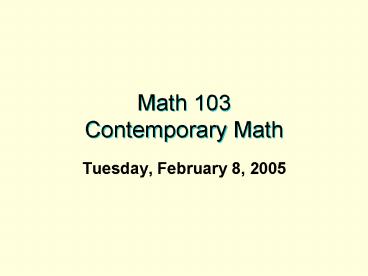Math 103 Contemporary Math - PowerPoint PPT Presentation
1 / 15
Title:
Math 103 Contemporary Math
Description:
... by the reflection. ... if there is a reflection R about the line l where R(P)=P' is ... Example: V will mean reflection across the line that is the ... – PowerPoint PPT presentation
Number of Views:28
Avg rating:3.0/5.0
Title: Math 103 Contemporary Math
1
Math 103 Contemporary Math
- Tuesday, February 8, 2005
2
Review from last class
- FAPP video on Tilings of the plane.
3
Symmetry Ideas
- Reflective symmetry BI LATERAL SYMMETRY
- T C O 0 I A
- Folding line "axis of symmetry"
- The "flip.
- The "mirror."
4
R(P) P' A Transformation
- Before P .... After P'
- If P is on the line (axis), then R(P)P. "P
remains fixed by the reflection." - If P is not on the axis, then the line PP' is
perpendicular to the axis and if Q is the point
of intersection of PP' with the axis then m(PQ)
m(P'Q).
5
Definition
- We say F has a reflective symmetry wrt a line l
if there is a reflection R about the line l
where R(P)P' is still an element of F for every
P in F.... - i.e.. R (F) F.
- l is called the axis of symmetry.
- Examples of reflective symmetrySquares...
People
6
Rotational Symmetry
- Center of rotation. "rotational pole" (usually O)
and angle/direction of rotation. - The "spin.
7
R(P) P' A transformation
- If O is the center then R(O) O.
- If the angle is 360 then R(P) P for all P....
called the identity transformation. - If the angle is between 0 and 360 then only the
center remains fixed. - For any point P the angle POP' is the same.
- Examples of rotational symmetry.
8
Single Figure Symmetries
- Now... what about finding all the reflective and
rotational symmetries of a single figure? - Symmetries of playing card....
- Classify the cards having the same symmetries.
Notice symmetry of clubs, diamonds, hearts,
spades. - ????
- Organization of markers.
9
Symmetries of an equilateral triangle
10
Why are there only six?
- Before A After A
or B or CSuppose I know where A
goesWhat about B? If A -gt A Before B
After B or C If A
-gtB BeforeB After A or C
If A -gtC Before B After A or
BBy an analysis of a "tree" we count there are
exactly and only 6 possibilities for where the
vertices can be transformed.
11
Tree Analysis
Identity
B
C
A
Reflection
C
B
C
Reflection
A
B
A
Rotation
C
B
Rotation
A
C
Reflection
A
B
12
What about combining transformations to give new
symmetries
- Think of a symmetry as a transformation
- Example V will mean reflection across the line
that is the vertical altitude of the equilateral
triangle.Then let's consider a second symmetry,
RR120, which will rotate the equilateral
triangle counterclockwise about its center O by
120 degrees. We now can think of first
performing V to the figure and then performing R
to the figure. We will denote this VR...
meaning V followed by R.Note that order can
make a difference here, and there is an
alternative convention for this notation that
would reverse the order and say that RV means V
followed by R.Does the resulting
transformation VR also leave the equilateral
covering the same position in which it started?
13
Symmetry Products
- VR ?
- If so it is also a symmetry.... which of the six
is it? - What about other products?
- This gives a "product" for symmetries.If S and
R are any symmetries of a figure then SR is also
a symmetry of the figure.
14
A "multiplication" table for Symmetries
15
Activity
- Do Activity.
- This shows that R240V ?
- This "multiplicative" structure is called the
Group of symmetries of the equilateral
triangle.Given any figure we can talk about the
group of its symmetries.Does a figure always
have at least one symmetry? .....Yes... The
Identity symmetry.Such a symmetry is called the
trivial symmetry.So we can compare objects for
symmetries.... how many?Does the multiplication
table for the symmetries look the same in some
sense?































